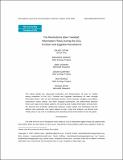| dc.contributor.author | Lotan, Gilad | |
| dc.contributor.author | Graeff, Erhardt | |
| dc.contributor.author | Ananny, Mike | |
| dc.contributor.author | Gaffney, Devin | |
| dc.contributor.author | Pearce, Ian | |
| dc.contributor.author | Boyd, Danah | |
| dc.date.accessioned | 2020-01-16T21:00:31Z | |
| dc.date.available | 2020-01-16T21:00:31Z | |
| dc.date.issued | 2011 | |
| dc.identifier.uri | https://hdl.handle.net/1721.1/123460 | |
| dc.description.abstract | This article details the networked production and dissemination of news on Twitter during snapshots of the 2011 Tunisian and Egyptian Revolutions as seen through information flows—sets of near-duplicate tweets—across activists, bloggers, journalists, mainstream media outlets, and other engaged participants. We differentiate between these user types and analyze patterns of sourcing and routing information among them. We describe the symbiotic relationship between media outlets and individuals and the distinct roles particular user types appear to play. Using this analysis, we discuss how Twitter plays a key role in amplifying and spreading timely information across the globe. | en_US |
| dc.language.iso | en | en_US |
| dc.publisher | International Journal of Communication | en_US |
| dc.subject | media analysis, social media, networks, civic media, activism | en_US |
| dc.title | The revolutions were tweeted: Information flows during the 2011 Tunisian and Egyptian revolutions | en_US |
| dc.type | Article | en_US |
| dc.contributor.department | Massachusetts Institute of Technology. Center for Civic Media | |
